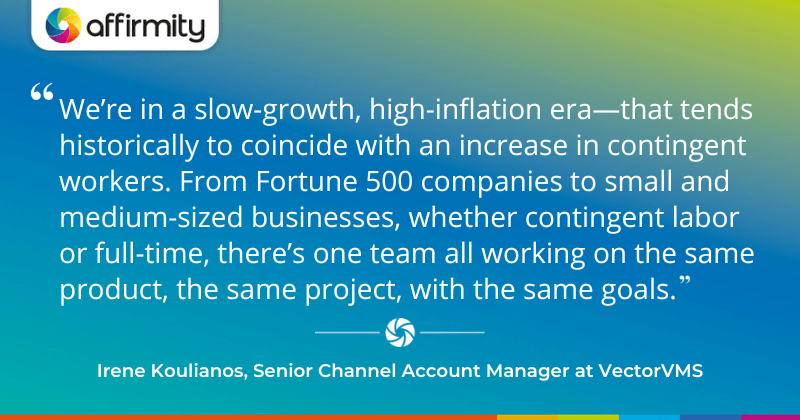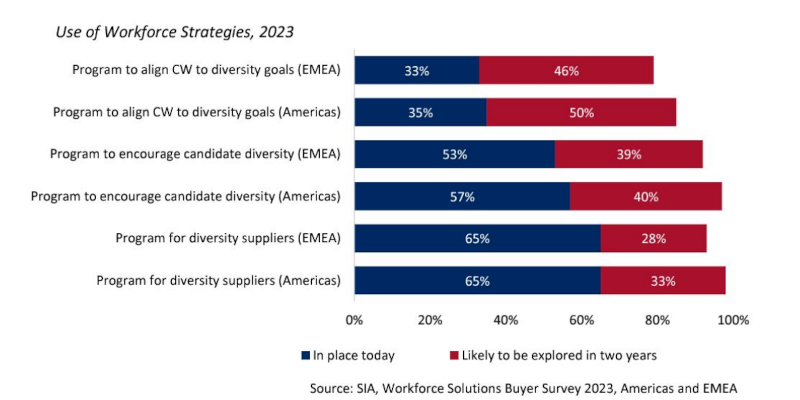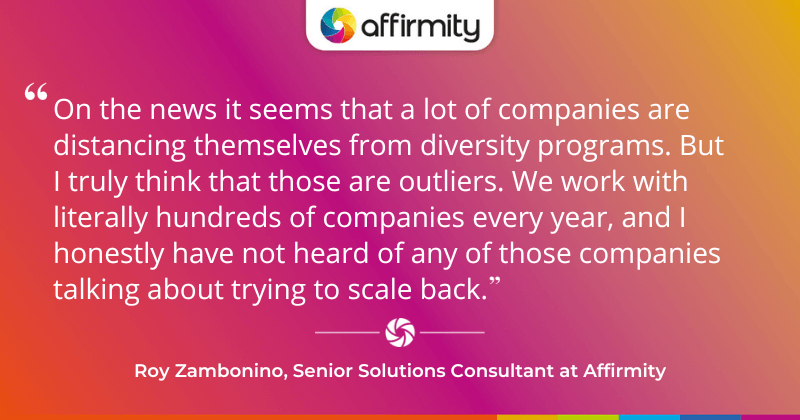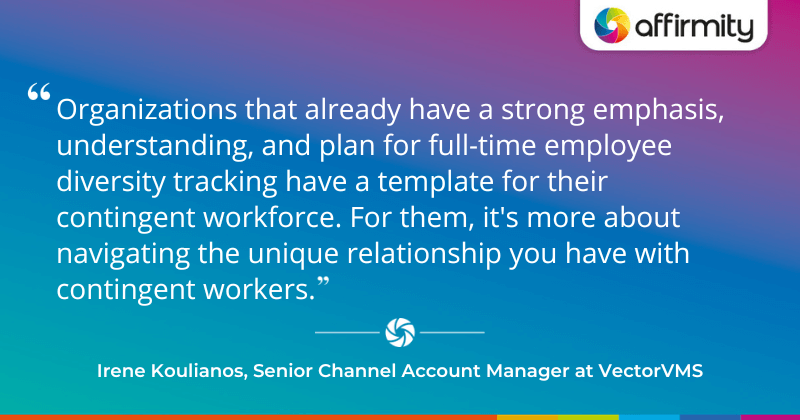The push toward more comprehensive diversity, equity, and inclusion practices must consider more than just the full-time workforce. In a recent Q&A session, Affirmity’s Vice President of Sales, Kim Hendon, and Senior Solutions Consultant, Roy Zambonino, joined Irene Koulianos, Senior Channel Account Manager at VectorVMS. Drawing on Affirmity’s experience in DE&I, and VectorVMS’s understanding of the contingent labor market, the discussion considers the wider trend of DE&I adoption and metrics, and explores why contract workers must not be left behind.
Q: What is driving the adoption of DE&I efforts in the workplace, whether full-time or contingent?
Kim Hendon: What we see is a continued increase of focus on diversity, equity, inclusion, and belonging in the workforce. According to a recent survey conducted by Randstad, 77% of workers globally say that they consider an employer’s values and purpose important, and 54% say they would quit if they didn’t sense they belonged at a company. Therefore, it seems obvious that a lack of understanding or long-term DE&I strategy, or a sacrifice of your DE&I programs will likely decrease employee engagement, increase turnover, and cause difficulty in attracting some key talent.

Irene Koulianos: In the United States, there’s a legislative push, especially by state governments. In Europe, there’s a push by their government entities to be more transparent about their diversity goals. What’s interesting from our perspective is that in states like California, the push is for both full-time and contingent. And even if companies aren’t headquartered in California, if they have sites and workers that are, they’re required to report on their DE&I for their total talent.
Another driver is the economy. We’re in a slow-growth, high-inflation era—that tends historically to coincide with an increase in contingent workers. From large Fortune 500 companies to small and medium-sized businesses, we’ve been hearing an increased appreciation that whether it’s contingent labor or full-time labor, there’s one team all working on the same product, the same project, with the same goals.
In order to be successful, you’ve got to make sure that your teams are set up for success—and it would be remiss for companies to ignore their total talent workforce. Because if they’re going to increasingly rely on contingent workers, and they’re still trying to reach their organizational goals, it’s still important to have diversity on the team.
They all appreciate that there’s evidence that diverse teams are more successful and innovative, and that they make their companies more recession-proof. Forbes once reported on this—a study showed that during the 2007-2009 recession, while the S&P 500 saw a 35.5% decline in stock performance, highly diverse and inclusive companies experienced a 14.4% gain. And it wasn’t a temporary increase. It showed that marginalized groups can bring different components and challenge different ways of thinking, which is what helps drive some of that innovation.
USE DE&I PUSHBACK TO EXPAND THE CONVERSATION | ‘How to Deal With DE&I Naysayers’
Q: How do your clients benefit from having a diverse workforce?
Roy Zambonino: We primarily work with the W-2 workforce (full-time employees whose earnings and taxes are reported using IRS form W-2) and we’ve rarely considered the contractor workforce in the past. Some of the things Irene has been talking about have opened my eyes to the possibilities, and how we could use that data.
The companies that we work with are primarily measuring things like race, gender, veteran representation, and disability representation. On the ERG front, they’re able to measure LGBTQ representation and allyship, and certainly that’s becoming more commonplace. By doing so, they’ve been seeing the benefits in terms of decrease of turnover, higher employee engagement, and the ability to attract talent. If we’re not looking at the labor contract workforce, I think we’re really missing out on an important part of the overall talent diversity strategy.
This said, some programs fail because there’s no real strategic vision as to why the organization is even implementing the program. They go through the motions and it just fizzles out because there’s no plan in place and no real commitment from the top down. A lack of realistic benchmarks is also a common problem. These are all things that an organization needs to straighten out, regardless of the focus of the program.

KH: Organizations are definitely becoming more interested in the concept of total talent diversity. Staffing Industry Analysts (SIA) conducted a survey in 2023 in both the Americas and EMEA that looked at current and intended diversity programs around contingent workers (see graph above). 65% said that they already had a program for diversity suppliers in place, and around 30% said they were likely to explore that in the next two years. And though only around a third said they had a program to align contingent workers to diversity goals, 50% of respondents said they planned to explore that within that same two-year timescale.
LEARN MORE ABOUT THE CURRENT STATE OF DE&I | ‘6 Major Takeaways From 2024’s Future of Diversity, Equity, Inclusion and Belonging Report’

Q: Are you seeing an increased appetite from your clients for diversity metrics?
RZ: Definitely! I know that, on the news, it seems that a lot of companies are distancing themselves from diversity programs and reevaluating their diversity programs. But I truly think that those are outliers. We work with literally hundreds of companies every year, and I honestly have not heard of any of those companies talking about trying to scale back. If anything, they’re trying to get more information.
One of the main drivers is really the changing dynamics of the workforce. Younger workers are a little bit more conscious about the organizations they’re going to be working with. So if you don’t have a diversity program you’re already behind when it comes to attracting that top talent.
During the ‘great resignation’, people quit their jobs and went to work for other companies that were paying them more money, that were more conscious about diversity, equity, and inclusion. Organizations still need to consider how they’re addressing the needs of those workers. For example, many took roles because they were going to be able to have the flexibility to work from home, but we’re seeing organizations consider back-to-office mandates. And that could actually impact their diversity. You’re forcing them back, to come into the office, but that may not be just a simple preference: it may not work for them based on the responsibilities they have and the other things they do.
I’ve been encouraging the companies that we work with to avoid negatively impacting existing diversity gains. They have insightful diversity metrics in place and as these programs are starting to mature, the result is that the stakeholders receiving these insights through reports and dashboards are starting to ask more questions. We’ve typically wanted to keep things simple for people, providing red/yellow/green status markers that explain at a glance how they’re doing. But now we’re getting people asking for more information on what’s driving those different colors and symbols on reports, which to me is great because that’s what we do.
And because we’ve always been about helping them gain visibility into areas they’ve typically not had visibility into, the possibility of providing insight into the contingent workforce is exciting. We’re finding that contractors follow a very different selection process. Furthermore, we’re also finding that the contractor workforce can feed directly into full-time positions in the workforce—and that could have a huge impact on the diversity in the W-2 workforce.
LEARN ABOUT LEADERSHIP BUY-IN | ‘How Accountability and Tailored Reporting Make or Break Data-Driven DE&I Management’

Q: Who are the typical early adopters of contingent candidate diversity tracking and what value do they gain?
IK: I recently led a roundtable discussion on DE&I and contingent workforce at the SIA’s conference in London, UK. My table was full, overflowing with people coming back several times. And I think that’s because of not only the conversations we were having, but the range of insights attendees were getting. We had everyone from HR at global financial institutions all the way through to more startup-size healthcare and engineering firms.
Organizations that already have a strong emphasis, understanding, and plan for full-time employee diversity tracking have a template for their contingent workforce. For them, it’s more about navigating the unique relationship you have with contingent workers. You have members of your team working for a manager on your team, but they were recruited by, and are technically employees of a third-party vendor. These clients need help applying their full-time models, and navigating this co-employment and their relationships with vendors.
The initial success is just even recognizing that it needs to happen and it needs to be tracked. In addition to being able to bring in more diverse talent, they benefit from thinking outside of the box and finding new ways to be innovative.
In terms of locations or industries, California and the northeast U.S., are locations where legislation has driven some of these conversations. But I’m also seeing it across many industries that are typically driven by one demographic where there’s this recognition of the benefits of having a more diverse team. Of course, they may want this, but they need to be going into schools and creating internship programs for women in STEM, working with local veteran programs to help upskill and alleviate costs around that, investing in the communities. The companies that do are the ones reaping the benefits, regardless of whether they’re bringing in contract workers or full-time workers.
If you would like to discuss how to create a more diverse, inclusive, and equitable organization, please contact us today.
About the Author
 Kim Hendon, Vice President of Sales, oversees account management and sales for Affirmity. She is responsible for building successful, long-term partnerships with clients for generating new business. Having served with the company for more than 20 years, Ms. Hendon has in-depth knowledge and broad experience in all areas of compliance and diversity.
Kim Hendon, Vice President of Sales, oversees account management and sales for Affirmity. She is responsible for building successful, long-term partnerships with clients for generating new business. Having served with the company for more than 20 years, Ms. Hendon has in-depth knowledge and broad experience in all areas of compliance and diversity.
Ms. Hendon assists clients with planning and development of affirmative action programs, diversity initiatives, and diversity training. She holds a Bachelor of Arts in Speech Communication and a Master’s in Business Administration.
